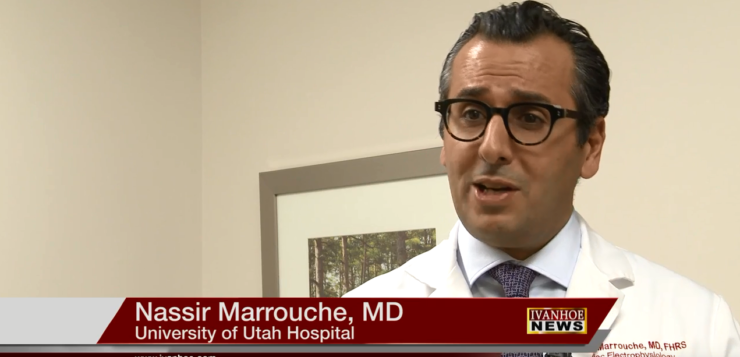Nassir F. Marrouche, MD, Professor; Internal Medicine, Cardiovascular Medicine, University of Utah Health, University Hospital talks about patients suffering from heart failure and atrial fibrillation and the CASTLE-AF study that is gathering more information on these patients conditions to help prevent future hospital visits and decrease mortality rates using catheter ablation to treat AFib.
Interview conducted by Ivanhoe Broadcast News in December 2018.
Tell us a little bit about the study, what does this study show?
Dr. Marrouche: CASTLE-AF was a study we conducted around nine years ago. We assessed efficacy of catheter ablation of Atrial Fibrillation in patients suffering from heart failure on primary heart end points of mortality and worsening heart failure admissions and hospitalization. We presented this data of the study at the European Study of Cardiology meeting and we’re very excited it’s coming out very soon in the New England Journal of Medicine. We showed for the first time ever that catheter ablation of Atrial Fibrillation does improve mortality by almost fifty percent reduction and improves heart failure admissions by forty six percent as well. This was fantastic news not only for us but for our heart failure patients who suffer from this Atrial Fibrillation. More than thirty percent of the heart failure population are suffering from or would suffer from Atrial Fibrillation at some time in their lives. And showing such a striking mortality and heart end point benefit was as we can imagine great news for our patients and for us as a treating physician community in cardiology.
So when you say fifty percent, forty percent is that over the rest of their lifetime, is that five years, ten years?
Dr. Marrouche: What we did for CASTLE-AF was we followed the patient for five years and we showed the mortality benefit; what happened over five years period by exactly forty eight percent reduction and the worsening heart failure admission reduction was forty seven percent. Now the reason why people live longer if you look carefully between the lines of this study and when you read the papers, the driver was a cardiovascular mortality. We achieved the fifty one percent reduction in cardiovascular mortality which seems to be the driver for the reason behind the results of CASTLE-AF. So it was very exciting for us. Also to report a significant reduction in cardiovascular hospitalization, which seems to be the driver for hospitalization, this is very important for the listeners or people who are watching us. We not only are improving patient’s lives and quality of life, that’s positive too by the way, and allowing our patient to live longer, but we are also keeping them away from the hospital. Within five to six months into the study we showed a significant reduction, effective hospitalization went down very quickly. You can imagine the impact of this on our health system because of cost. Hospitalization is not only keeping the patient away from the hospital and their quality of life but keeping them away from the hospital helps us save lot of money in terms of the costs associated with this treatment. None of the drug studies, if you look at all of the studies that have been done so far have this striking effect that early on if you compare previous data.
If it weren’t catheter ablation were patients trying to control this with drugs, behavior lifestyle before?
Dr. Marrouche: That’s an excellent question. Yes, the controller, what we can put the ablation to. At the randomized study that’s what CASTLE was is a randomized prospective control study comparing ablation versus conventional pharmacological treatment of heart failure in applying the guidelines of heart failure management in patients of Atrial Fibrillation and vice versa. These patients until today and most of them still are treated with heart failure medication and with drugs to control their rhythm. There’s a lot of drugs available out there but there’s unfortunately only two we usually can use in this patient population. And we showed in this study that these drugs unfortunately don’t help. And even worse the patient who did better were not taking these drugs. So these drugs shown in previous studies as well they don’t help and I don’t want to use the word killed, but they make the mortality benefit worse or make it worse if you use these drugs. So the status quo of treating these patients is not working. And not only it’s not working we proved in CASTLE, but there’s an alternative treatment that we should be applying to these patients. Hopefully our paper and our data in CASTLE, it’s already happening actually as we speak but, will penetrate fast this community of patients. We have more than twenty five million heart failure patients in this country and more than six million Afib patients. So hopefully we can set up these treatments again to achieve three things. Improve mortality, keep the patient away from the hospital and improve costs, and keep away from taking drugs that will affect their quality of life and the side effects and so on.
The trial was strictly for patients who already were in heart failure and then subsequently had Afib experience?
Dr. Marrouche: Yes this study CASTLE-AF looked at the inclusion criteria in CASTLE-AF which will answer other questions. Patients have to have persistent proximal Atrial Fibrillation; any kind of Atrial Fibrillation with an ejection fraction less than thirty five percent. That means a weak heart muscle and also to have high class association symptoms of two or more. So two, three and four, we don’t include the one in this study. They need to have an ICV defibrillator implanted because all the studies show that these patients with ICV they will do better and live longer if they have the defibrillator. So they have to have the defibrillator which helps and CASTLE intends monitoring their rhythm as well. That’s inclusion criteria for a heart failure patient. The reason why we chose this population is because we knew the mortality rate is very high in this population. And anything we can do and improve in a very tough, sick population; if we can prove Atrial Fibrillation works in those types of patients then applying it somewhere else would be way easier. But these are sick patients if you look at the inclusion criteria. And we could show that striking benefit of this study was you know great, great news for everybody.
So then what’s next, do you look at different segments of population?
Dr. Marrouche: Yes, someone asked me that question. We at the University for the last eleven years, one of the reasons why I moved here actually, we took advantage of our OR imaging infrastructure. We do and have been doing standardized … actually the guidelines recently have been applying our work as well in imaging and personalizing precession medicine in applying treatments. We’re using imaging at the University because the University is very well known for their advance imaging programs. So within the center to build our imaging and our arrhythmia management we defined a new treatment of arrhythmias by applying precision medicine; this concept by imaging the hearts using MRI scans. So the MRI will tell me at which stage of the disease how much scarring they have within their hearts and then based on this information we could not only define the best treatment option for the patient, but also predict the worse outcomes like strokes and heart failure and start preventing early on. So the next big thing for us is as you know, I wish I could help every single patient in CASTLE; there’s still a big room for precision medicine in CASTLE-AF which some patients in this group will profit more than others. The people who had ablation, not everybody lived, not everybody stayed away from the hospital. So if we can still dissect this information based on phenotyping their image and understanding their heart and the amount of scarring; that’s the next big thing we’re working on now is how can we use scar imaging for the people that doesn’t know what fibrosis means. They’re using MRI scanning to understand the responders and non-responders and how to apply this treatment for more precise and specific patients who will profit better than others.
So you’re going to stay inside this population?
Dr. Marrouche: We are already outside this population and out study is ongoing. The DECAAF-2 study. We published from Utah the DECAAF-1 in Jama three years ago where we showed that this kind of approach. This technique of imaging hearts before we treat them, we could define people to treat with the blinded study and we showed the fact that the more scarring you have the less effect of the treatment. So now with DECAAF-2 is we’re trying to treat everybody with Afib. Normal hearts, healthy hearts and there’s some of them with bad hearts but with diseased hearts and with heart failure. But we’re trying to understand if we treat this scarring do we improve outcomes so this is a big study, a thousand patients worldwide ongoing as we speak; we’re half way in actually. So the next population for CASTLE, we learned from CASTLE we learned a lot. A major example is if the patient came to see you today with Atrial Fibrillation the first question they ask is, sir was I having Afib all the time or having Atrial Fibrillation every other day, I feel it. But now after the procedure I have it every month. What did that mean, we never knew what that means, it’s called the Afib burden; the amount of Atrial Fibrillation that the patient is suffering from. With CASTLE-AF what we’re learning from the study is because they have the defibrillators and the devices so we have every single heartbeat on these patients for five years. Now we start to collect the amount of Afib needed to send the patient to the hospital. The amount of Afib needed to cause mortality, amount of Afib needed for etc. So that’s a lot of data that is going to come out of CASTLE which is going to change the way we do things. Is an end point of a procedure or treatment Afib of five seconds or sixty seconds or two days or we don’t care, just create something. That’s why we’re excited with this continuous monitoring that we have in CASTLE. That we’ve gone through tons of stuff; we’re just starting and I’m so excited. Was excited with our team and the amount of data that we’re going to tap into which will help with educating the community and so on.
END OF INTERVIEW
This information is intended for additional research purposes only. It is not to be used as a prescription or advice from Ivanhoe Broadcast News, Inc. or any medical professional interviewed. Ivanhoe Broadcast News, Inc. assumes no responsibility for the depth or accuracy of physician statements. Procedures or medicines apply to different people and medical factors; always consult your physician on medical matters.
If you would like more information, please contact:
Dr. Nassir Marrouche
Nassir.marrouche@carma.utah.edu
Toni Atkin
Sign up for a free weekly e-mail on Medical Breakthroughs called First to Know by clicking here




